ANTIQUE
TOY WORLD
Magazine — November, 1991, Volume 21 Number 11
(web
note, transcribed text for key word searching
is under the page images)
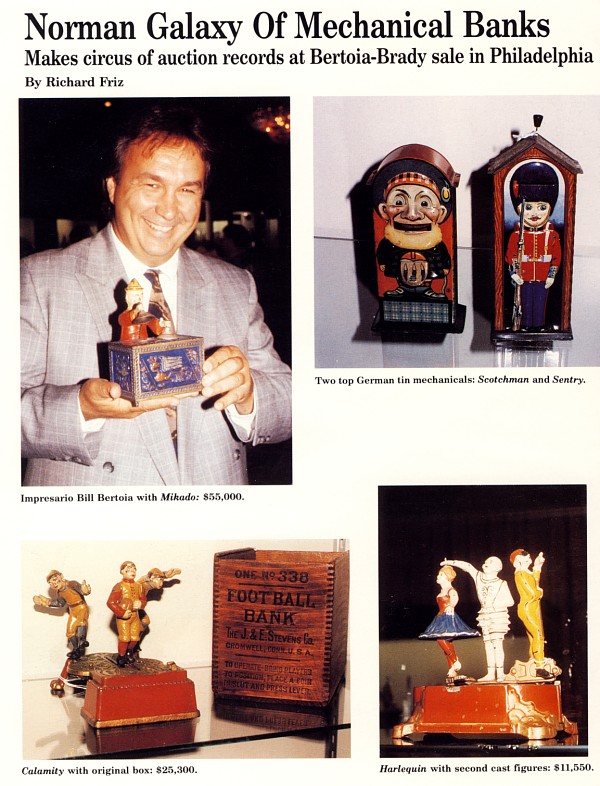
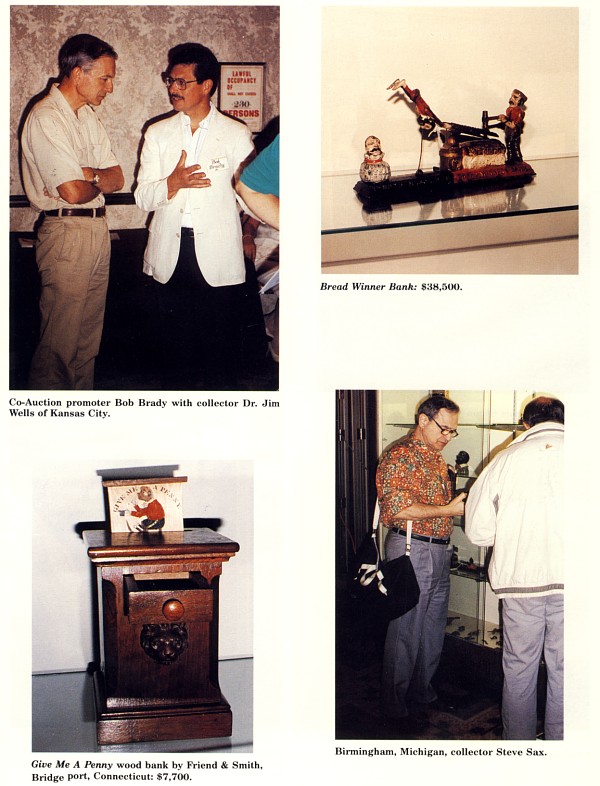
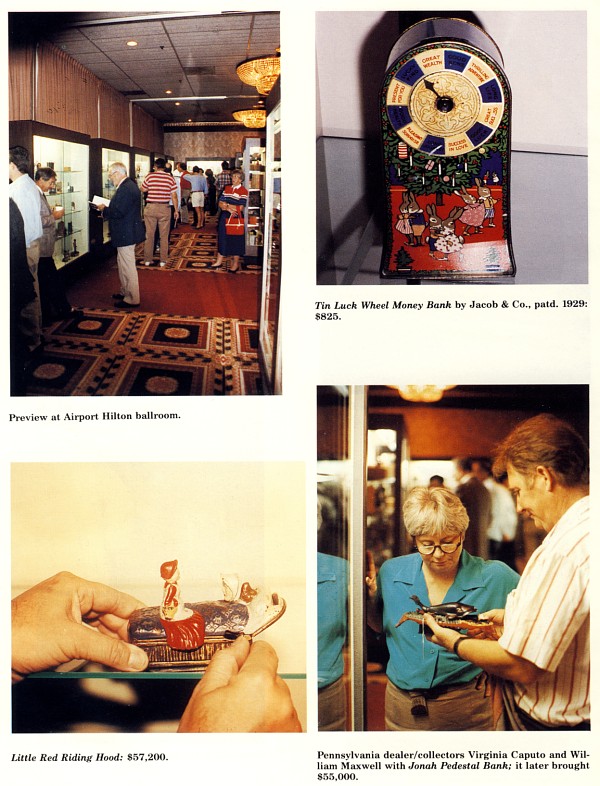
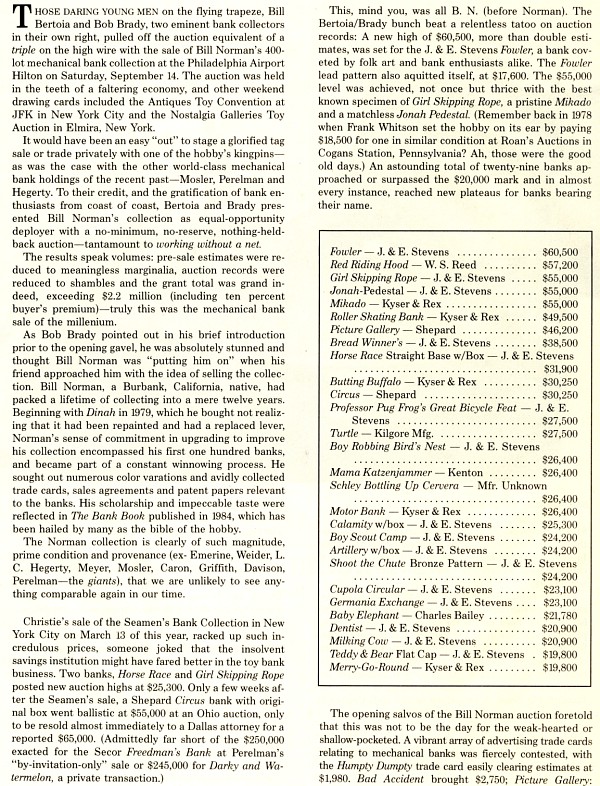
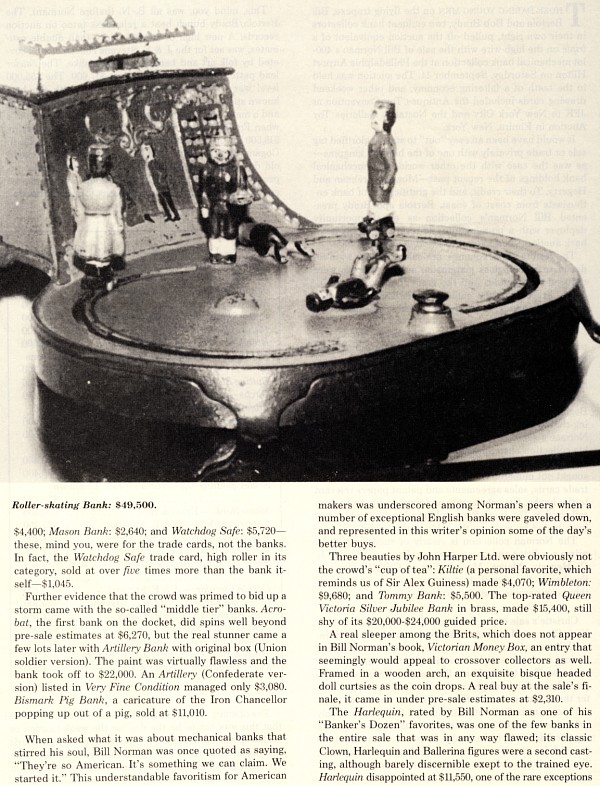
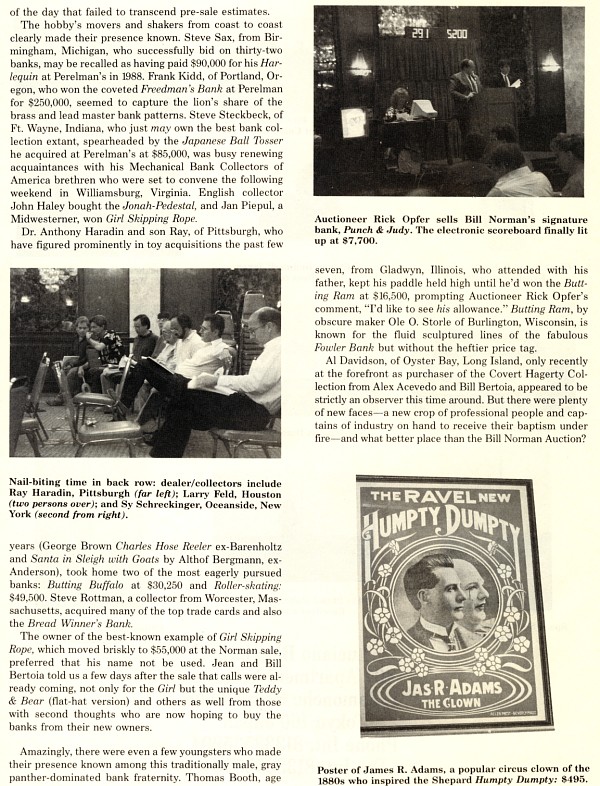
ANTIQUE
TOY WORLD
Magazine — November, 1991, Volume 21 Number 11
Norman
Galaxy Of Mechanical Banks
Makes circus of auction records at Bertoia-Brady sale in Philadelphia
by Richard Friz
THOSE DARING YOUNG MEN on the flying trapeze, Bill Bertoia and Bob
Brady, two eminent collectors in their own right, pulled off the auction
equivalent of a triple
on the high wire with the sale of Bill Norman's 400-lot mechanical bank
collection at the Philadelphia Airport Hilton on Saturday, September 14.
The auction was held in the teeth of a faltering economy, and other
weekend drawing cards included the Antiques Toy Convention at JFK in New
York City and the Nostalgia Galleries Toy Auction in Elmira, New York.
It would have been an easy "out" to stage a glorified tag sale or
trade privately with one of the hobby's kingpins — as was the case with
the other world-class mechanical bank holdings of recent past — Mosler,
Perelman and Hegerty. To their credit, and the gratification of
bank enthusiasts from coast to coast, Bertoia and Brady presented Bill
Norman's collection as equal-opportunity deployer with a no-minimum,
no-reserve, nothing-held-back auction — tantamount to
working without a net.
The results speak volumes: pre-sale estimates were reduced to
meaningless marginalia, auction records were reduced to shambles and the
grand total was grand indeed, exceeding $2.2 million (including ten
percent buyer's premium) — truly this was the mechanical bank sale of
the millennium.
As Bob Brady pointed out in his brief introduction prior to the
opening gavel, he was absolutely stunned and thought Bill Norman was
"putting him on" when his friend approached him with the idea of selling
the collection. Bill Norman, a Burbank, California, native, had packed a
lifetime of collecting into a mere twelve years. Beginning with
Dinah in 1979,
which he bought not realizing that it had been repainted and had a
replaced lever, Norman's sense of commitment in upgrading to improve his
collection encompassed his first one hundred banks, and became part of a
constant winnowing process. He sought out numerous color variations and
actively collected trade cards, sales agreements and patent papers
relevant to the banks. His scholarship and impeccable taste were
reflected in The Bank
Book published in 1984, which has been hailed by many as the
bible of the hobby.
The Norman Collection is clearly of such magnitude, prime condition
and provenance (ex-Emetine, Weirder, I. C. Hegerty, Meyer, Mosler,
Caron, Griffith, Davidson, Perelman — the
giants), that we
are unlikely to see anything comparable again in our time.
Christie's sale of the Seamen's Bank Collection in New York City on
March 13 of this year, racked up such incredulous prices, someone joked
that the insolvent savings might have fared better in the toy bank
business. Two banks,
Horse Race and
Girl Skipping Rope
posted new auction highs at $25,300. Only a few weeks after the Seamen's
sale, a Shepard Circus
bank with original box went ballistic at $55,000 at an Ohio auction,
only to be resold almost immediately to a Dallas attorney for a reported
$65,000. (Admittedly far short of the $250,000 exacted for the Secor
Freedman's Bank
at Perelman's "by-invitation-only" sale or $245,000 for
Darky and Watermelon,
a private transaction.)
This, mind you, was all B. N. (Before Norman). The Bertoia/Brady
bunch beat a relentless tatoo on auction records: A new high of $60,500,
more than double estimate, was set for the J. & E. Stevens
Fowler, a bank
coveted by folk art and bank enthusiasts alike. The
Fowler lead
pattern also acquitted itself, at $17,000. The $55,000 level was
achieved, not once but thrice with the best known specimen of
Girl Skipping Rope,
a pristine Mikado
and a matchless Jonah
Pedestal (Remember back in 1978 when Frank Whitson set the
hobby on its ear by paying $18,500 for one in similar condition at
Roan's Auctions in Cogans Station, Pennsylvania? Ah, those were the good
old days.) An astounding total of twenty-nine banks approached or
surpassed the $20,000 mark and in almost every instance, reached new
plateaus for banks bearing their name.
Fowler — J. & E. Stevens . . . $60,500
Red Riding Hood — W. S. Reed . . . $57,200
Girl Skipping Rope — J. & E. Stevens . . . $55,000
Jonah-Pedestal — J. & E. Stevens . . . $55,000
Mikado — Kyser & Rex . . . $55,000
Roller Skating Bank — . . . $49,500
Picture Gallery — Shepard . . . $46,200
Bread Winner's — J. & E. Stevens . . . $38,500
Horse Race Straight Base w/Box — J. & E. Stevens . .
. $31,900
Butting Buffalo — Kyser & Rex . . . $30,250
Circus — Shepard . . . $30,250
Professor Pug Frog's Great Bicycle Feat — J. & E.
Stevens . . . $27,500
Turtle — Kilgore Mfg. . . . $27,500
Boy Robbing Bird's Nest — J. & E. Stevens . . .
$26,400
Mama Katzenjammer — Kenton . . . $26,400
Schley Bottling Up Cervera — Mfr. Unknown . . .
$26,400
Motor Bank — Kyser & Rex . . . $26,400
Calamity w/box — J. & E. Stevens . . . $25,300
Boy Scout Camp — J. & E. Stevens . . . $24,200
Artillery w/box — J. & E. Stevens . . . $24,200
Shoot the Chute Bronze Pattern — J. & E. Stevens . .
. $24,200
Cupola Circular — J. & E. Stevens . . . $23,100
Germania Exchange — J. & E. Stevens . . . $23,100
Baby Elephant — Charles Bailey . . . $21,780
Dentist — J. & E. Stevens . . . $20,900
Milking Cow — J. & E. Stevens . . . $20,900
Teddy & Bear Flat Cap — J. & E. Stevens . . . $19,800
Merry-Go-Round — Kyser & Rex . . . $19,800
The opening salvos of the Bill Norman auction foretold that this
was not to be the day for the weak-hearted or shallow-pocketed. A
vibrant array of advertising trade cards relating to mechanical banks
was fiercely contested, with the
Humpty Dumpty
trade card easily clearing estimates at $1,980.
Bad Accident
brought $2,750; Picture
Gallery: $4,400;
Mason Bank: $2,640; and
Watchdog Safe:
$5,720 — these, mind you, were for trade cards, not the banks. In fact,
the Watchdog Safe
trade card, a high roller in its category, sold at over
five times more
than the bank itself — $1,045.
Further evidence that the crowd was primed to bid up a storm came
with the so-called "middle tier" banks.
Acrobat, the
first bank on the docket, did spins well beyond pre-sale estimates at
$6,270, but the real stunner came a few lots later with
Artillery Bank with original box (Union soldier version).
The paint virtually flawless and the bank took off to $22,000. An
Artillery
(Confederate version) listed in
Very Fine Condition
managed only $3,080.
Bismark Pig Bank, a caricature of the Iron Chancellor
popping up out of a pig, sold at $11,010.
When asked what it was about mechanical banks that stirred his
soul, Bill Norman was once quoted as saying, "They're so American. It's
something we can claim. We started it." This understandable favoritism
for American makers was underscored among Norman's peers when a number
of exceptional English banks were gaveled down, and represented in this
writer's opinion some of the day's better buys.
The beauties by John Harper Ltd. were obviously not the crowd's
"cup of tea": Kiltie
(a personal favorite, which reminds us of Sir Alex Guiness) made $4,070;
Wimbleton:
$9,680; and Tommy Bank:
$5,500. The top-rated
Queen Victoria Silver Jubilee Bank in brass made $15,400,
still shy of its $20,000-$24,000 guided price.
A real sleeper among the Brits, which does not appear in Bill
Norman's book, Victorian
Money Box, an entry that seemingly would appeal to crossover
collectors as well. Framed in a wooden arch, an exquisite bisque headed
doll curtsies as the coin drops. A real buy at the sale's finale, it
came in under pre-sale estimates at $2,310.
The Harlequin,
rated by Bill Norman as one of his "Banker's Dozen" favorites, was one
of the few banks in the entire sale that was in any way flawed; its
classic Clown, Harlequin and Ballerina figures were a second casting,
although barely discernible except to the trained eye.
Harlequin
disappointed at $11,550, one of the rare exceptions of the day that
failed to transcend pre-sale estimates.
The hobby's movers and shakers from coast to coast clearly made
their presence known. Stan Sax, from Birmingham, Michigan, who
successfully bid on thirty-two banks, may be recalled as having paid
$90,000 for his
Harlequin at Perelman's in 1988. Frank Kidd, of Portland,
Oregon, who won the coveted
Freedman's Bank
at Perelman for $250,000, seemed to capture the lion's share of the
brass and lead master bank patterns. Steve Steckbeck, of Ft. Wayne,
Indiana, who just may
own the best bank collection extant, spearheaded by the
Japanese Ball Tosser
he acquired at Perelman's at $85,000, was busy renewing acquaintances
with his Mechanical Bank Collectors of America brethren who were set to
convene the following weekend in Williamsburg, Virginia. English
collector John Haley bought the
Jonah-Pedestal,
and Jan Piepul, a Midwesterner, won
Girl Skipping Rope.
Dr. Anthony Haradin and son Ray, of Pittsburgh, who have figured
prominently in toy acquisitions the past few years (George
Brown Charles Hose Reeler ex-Barenholtz and
Santa in Sleigh with Goats
by Althof Bergmann, ex-Anderson), took home two of the most eagerly
pursued banks: Butting
Buffalo at $30,250 and
Roller-skating;
$49,500. Steve Rottman, a collector from Worcester, Massachusetts,
acquired many of the top trade cards and also the
Bread Winner's Bank.
The owner of the best-known example of
Girl Skipping Rope,
which moved briskly to $55,000 at the Norman sale, preferred that his
name not be used. Jean and Bill Bertoia told us a few days after the
sale that calls were already coming, not only for the
Girl but the
unique Teddy & Bear
(flat-hat version) and others as well from those with second thoughts
who were now hoping to buy the banks from their new owners.
Amazingly, there were even a few youngsters who made their presence
known among this traditionally male, gray panther-dominated bank
fraternity. Thomas Booth, age seven, from Gladwyne, Illinois, who
attended with his father kept his paddle held high until he'd won
Butting Ram at $16,500, prompting Auctioneer Rick Opfer's
comment, "I'd like to see
his allowance."
Butting Ram,
by obscure maker Ole O. Storle of Burlington, Wisconsin, is known for
the fluid sculptured lines of the fabulous
Fowler Bank but
without the heftier price tag.
Al Davidson, of Oyster Bay, Long Island, only recently at the
forefront as purchaser of the Covert Hagerty Collection from Alex
Acevedo and Bill Bertoia, appeared to be strictly an observer this time
around. But there were plenty of new faces — a new crop of professional
people and captains of industry on hand to receive their baptism under
fire — and what better place than the Bill Norman Auction?
|